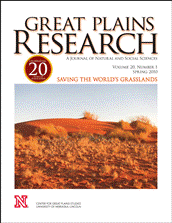Center for Great Plains Studies

Great Plains Research: A Journal of Natural and Social Sciences (through 2013)
Date of this Version
2003
Document Type
Article
Abstract
This book is one of several dealing with cranes in recent years. Most offer general information and are not intended to be technical. As someone deeply interested in the plight of cranes, I applaud these efforts for increasing the general public's awareness of cranes and their conservation problems. It is well known that cranes in general have held important connections with human cultures in various parts of the world. Cranes the Noblest Flyers is an effort to explore and present some of those connections, intertwined with information on the family members and the situation of their representatives in current-day North America. The book mixes personal observations and impressions as well as philosophical discourses presented as metaphors with what other cultures may have felt and done in the past. Most sections begin with facts or an intriguing narrative, and proceed into other cultures' perspectives on or relationships with cranes. Though presenting an abundance of fascinating information in one place, the book at times is hard to follow. For example, the author's description of the awesome phenomenon of Sandhill cranes staging in the Platte River suddenly veers into an account of the phoebe she heard and where the name comes from. In a section on whooping cranes much space is spent on peregrine falcons. Granted that we can easily be sidetracked while observing nature because of the wide variety of events unfolding around us, a book whose stated objective is a natural history of sandhills and whooping cranes would have benefitted from the deletion of such distractions. Viewed in terms of its objectives, it also might have been better organized, with all the natural history information presented separate from the philosophical and cultural issues. There are good sections on the natural history of cranes, along with material on the people who work with cranes, though some historical and factual information has been left out.


Comments
Published in Great Plains Research Vol. 13, No.1, 2003. Copyright © 2003 Center for Great Plains Studies, University of Nebraska – Lincoln. Used by permission.